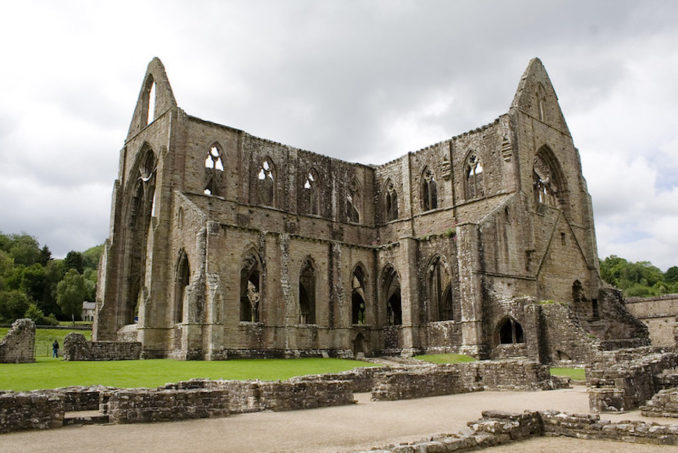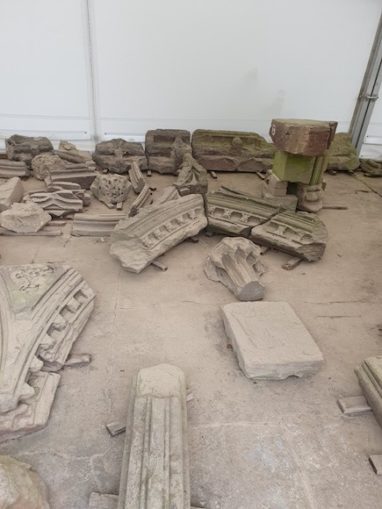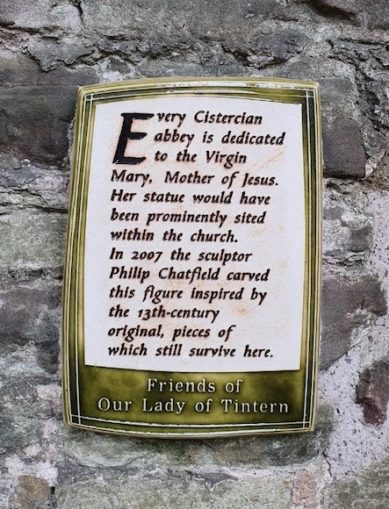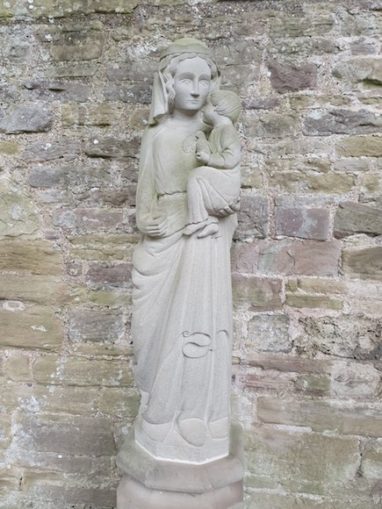Tintern Abbey (or Abaty Tyndryn if you speak Welsh) was founded on 9th May 1131 by Walter de Clare, Lord of Chepstow. It is located near the border between Wales and England (Gloucestershire) on the west bank of the River Wye, next to the village of Tintern.
The remains of Tintern are a mixture of building works covering a 400-year period between 1131 and 1536. Very little of the first buildings survives today; a few sections of walling are incorporated into later buildings. The Abbey was mostly rebuilt during the 13th century and the first mass in the rebuilt presbytery was recorded to have taken place in 1288, with the building was consecrated in 1301, although building work continued for several decades after.

Tintern Abbey,
Mark Fowler – Licence CC BY-SA 2.0
Several decades have passed by since I last visited Tintern Abbey. I can just about remember my trip there with mum, dad and my brother and his wife. I guess I was about 7 years old and don’t remember much of the day other than parking in the car park and looking across to the Abbey. I certainly can’t remember ever walking around the Abbey grounds, but I guess we must have.
Mrs Reggie and I were on our way back from a trip to Crickhowell (a lovely little town with several art and craft shops/galleries) and decided to visit the Abbey as it was kind of on our way home. We took the scenic route across the top of a mountain between the A449 and the A446. It gave us some stunning views of the local countryside, with some very large and exclusive properties dotted about as we drove past. Very pretty and should we win the lottery I would certainly consider moving there.
Arriving at Tintern Abbey we parked up and headed to the entrance building. We paid the entry fee and headed on through towards the abbey. Outside there were a collection of stones recovered from the ruins and kept undercover to keep them preserved.

© Reggie’s Mind of Evil, Going Postal 2021
Walking towards the main abbey buildings we noted various buildings outside the Abbey, such as the kitchens, infirmary and sleeping quarters. In the grounds outside the abbey we spotted at least 4 artists painting various views of the abbey, mostly in watercolour. Evidently a favourite spot for them and from what we saw they were all experienced painters.
It isn’t possible to walk inside most of the abbey building due to the danger of falling stones, however one section is open to the public and we wandered through and took a few photos.

© Reggie’s Mind of Evil, Going Postal 2021

© Reggie’s Mind of Evil, Going Postal 2021
Near the point where you are prevented from walking any further, a modern sculpture has been erected, based on 13th-century originals.

© Reggie’s Mind of Evil, Going Postal 2021

© Reggie’s Mind of Evil, Going Postal 2021
Heading back towards the entrance building we read up on some of the history of Tintern:-
King Edward II stayed at Tintern for two nights in 1326. When the Black Death swept the country in 1349, it became impossible to attract new recruits for the lay brotherhood; during this period, the granges were more likely to be tenanted out than worked by lay brothers, evidence of Tintern’s labour shortage. In the early 15th century, Tintern was short of money, due in part to the effects of the Welsh uprising under Owain Glyndŵr against the English kings, when abbey properties were destroyed by the Welsh.
In the reign of Henry VIII, the dissolution of the monasteries ended monastic life in England, Wales and Ireland. On 3 September 1536, Abbot Wych surrendered Tintern Abbey and all its estates to the king’s visitors and ended a way of life that had lasted 400 years. Valuables from the abbey were sent to the Royal Treasury and Abbot Wych was pensioned off. The building was granted to the then lord of Chepstow, Henry Somerset, 2nd Earl of Worcester. Lead from the roof was sold and the decay of the buildings began.
Following the abbey’s dissolution, the adjacent area became industrialised with the setting-up of the first wireworks by the Company of Mineral and Battery Works in 1568 and the later expansion of factories and furnaces up the Angidy Valley. Charcoal was made in the woods to feed these operations and, in addition, the hillside above was quarried for the making of lime at a kiln in constant operation for some two centuries.
By the mid-18th century, it became fashionable to visit “wilder” parts of the country. The Wye Valley in particular was well known for its romantic and picturesque qualities and the ivy-clad abbey was frequented by tourists. In 1901, Tintern Abbey was bought by the Crown from the Duke of Beaufort for £15,000 and the site was acknowledged as a monument of national importance. Although there had been some repair work done in the ruins as a result of the 18th-century growth of tourism, it was not until now that archaeological investigation began and informed maintenance work was carried out on the abbey. In 1914, responsibility for the ruins was passed to the Office of Works, who undertook major structural repairs and partial reconstructions (including removal of the ivy considered so romantic by the early tourists). In 1984, Cadw took over responsibility for the site, which was Grade I listed from 29 September 2000. The arch of the abbey’s watergate, which led from the abbey to the River Wye, was Grade II listed from the same date.
All in all our visit to Tintern Abbey lasted about an hour. It’s not the largest of sites (in comparison to Fountains Abbey, for example) and having walked around the site and taken in the views we headed back towards the car. An enjoyable experience and well worth a visit.
Hope you enjoyed this postcard.



